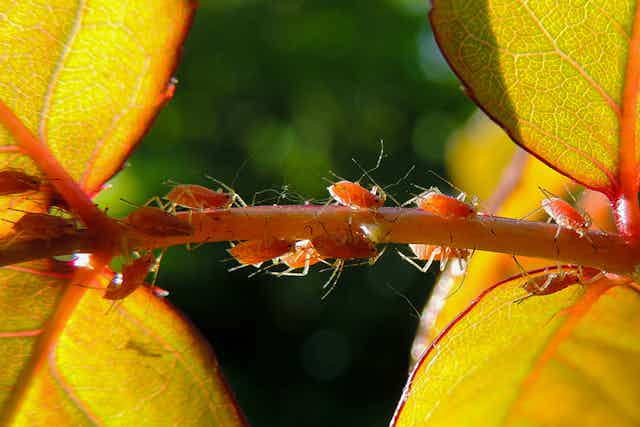Internal communications in plants share striking similarities with those in animals, new research reveals. With the help of tiny insects, scientists were able to tap into this communication system. Their results reveal the importance of these communications in enabling plants to protect themselves from attack by insect pests.
Like any organism, plants need to transport essential nutrients from one part to another. This is achieved by two parts of the plant: the xylem and the phloem. Xylem, which is largely made of dead cells, transports water and dissolved nutrients obtained by roots up to the aerial tissues of the plants. By contrast, the phloem is made up of living cells – active tubes that transport a syrupy sap, rich in sugars made by photosynthesis in the leaves.
In the 1980s, scientists discovered that phloem cells also function as a communication system through which electrical signals travel. This is similar to the electrical signals transmitted through the neurons in your nervous system.
In both plants and animals, electrical signals function in an analogous manner. They transmit information from one location to another. If someone wounded your hand, an electrical signal travels through neurons from your skin, up your arm, to your brain, to let you know you have been wounded, and to draw your hand away. Similarly, when a herbivore wounds a plant, an electrical signal is generated which, instead of travelling to a centralised brain, travels through the phloem to other parts of the plant, informing them that wounding has occurred.
Tapping into defence
Wounding means danger in plants because it normally happens when the plant is becoming some herbivore’s meal. The ability of a wounded part of the plant to let other parts know that wounding has occurred can help prepare against the attack. Plants have a suite of sophisticated defences that they can bring to bear to protect themselves from herbivores.
Some herbivores don’t wound plants as much as they nibble. Nibbling may escape the detection of the plant, but could have dire consequences—a lot of nibbling can be as fatal as a big bite. But it has been difficult to determine if plants are able to detect nibbling and transmit a warning signal, in the same manner as they do when wounded.
Vicenta Salvador-Recatalà of the University of Lausanne and her colleagues used aphids – specialised insects that feed on plants – to find out how the phloem network responds to nibbling by caterpillars. Their results have been published in the journal New Phytologist.
Aphids feed by using their straw-like mouths, which penetrate deep into the plant. As long as there aren’t too many aphids, it doesn’t harm the plant much. In fact, it is in the aphid’s interest to ensure that the plant remains healthy, so that there is still plenty of its sugary syrup to be had.
Aphids don’t just connect themselves to the internal plumbing; they’re also tapped in to the plant’s internal communication system. The aphid’s mouth drills into the phloem, is not easily dislodged, and doesn’t break. This means that aphids that are attached to the plant’s phloem can then be converted into living electrodes. A living-aphid-electrode system can be used to detect electrical signals transmitted through the plant body without causing additional damage to the plant – damage that can set off the plants’ warning system and confuse the results.
Using this aphid phloem-tapping system, Salvador-Recatalà and colleagues investigated the transmission of electrical signals in response to caterpillar feeding. They found that even the nibbling of caterpillars could induce electrical signals, on a smaller scale, but akin to those transmitted by wounding.
The electrical signals travelled like waves, spreading most rapidly to leaves that were closest to the site of caterpillar feeding, and more slowly to other regions of the plant. When the waves were rapid, a wound response was activated on surrounding leaves – beyond the one that the caterpillar was nibbling on.
Behaving like animals
In neurons in animals, electrical waves are transmitted by virtue of changes in the way charged atoms flow into and out of the cell. The flow of these charged atoms is controlled by protein channels embedded in the membrane of neurons. In the absence of a signal, the channels are closed. When a neuron receives the right signal, these channels open, allowing the ions to flow out through the channel. This induces a change in ion concentrations inside the cell, and thereby creates the electrical wave.
Plants make protein channels that are similar to those found in neurons. They also open and close in response to appropriate signals, and, when open, allow ions, especially calcium, to flow. When Salvador-Recatalà and colleagues looked at plants where the function of some of these channels was impaired, they found that caterpillar feeding no long produced electrical waves.
These findings suggest that plants respond to caterpillar nibbling using an electrical signalling network that functions through the same mechanics that neurons rely on. Clearly, plants don’t have neurons, but they make use of similar molecular building blocks to construct a response network.
While aphid spies do have their drawbacks – after all, they are also feeding on the plant – these little parasites are inadvertently providing us with profound insights into how their host plants function. The “wiretapping capabilities” they provide are likely to uncover other secrets encoded in plant responses to a variety of threats, including those of the aphids’ relatives: insect pests.

